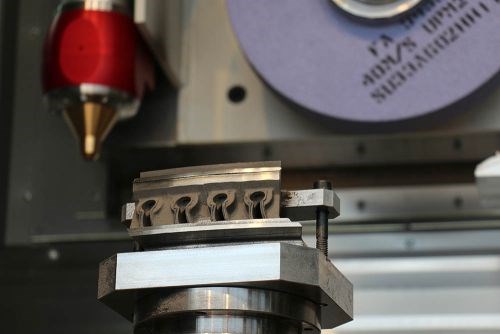New Hybrid Unites Additive Manufacturing and Grinding
A machine performing surface and profile grinding, along with milling and laser metal deposition, is believed to be the world’s first hybrid grinder.
Share





Autodesk, Inc.
Featured Content
View More
Takumi USA
Featured Content
View More


ECi Software Solutions, Inc.
Featured Content
View More
Hwacheon Machinery America, Inc.
Featured Content
View More


Using the hybrid grinder, this stator vane section was resurfaced via metal deposition, then machined to the part’s final tolerance via grinding.
To date, hybrid machine tools have combined additive manufacturing capability with milling and/or turning. But now, machine tool maker ELB-Schliff has introduced a grinding machine that is equipped for additive manufacturing. The hybrid version of the company’s “millGrind” is aimed at aerospace engine part production, producing part features both subtractively (through grinding and milling) and additively (through laser cladding). In other words, the machine can generate the features of precise, complex, critical components made aerospce alloys by applying both growing and grinding within a single cycle.
The additive capability comes from the laser metal deposition system from Hybrid Manufacturing Technologies that is integrated into the machine. Hybrid worked with ELB-Schliff on the machine’s development. The result, both companies believe, is the world’s first hybrid grinder.
The combination makes sense. Indeed, it could be argued that additive manufacturing is at least as good a fit with grinding as it is with other subtractive operations. Both CNC grinding and metal additive manufacturing are high-value processes typically performed on high-end machines. In addition, grinding is strong where additive is weak. Features produced additively generally require surface finish improvement, and surface finish is where grinding excels.
A statement from ELB-Schliff adds this: “Grinding particularly excels in cost-effectiveness for processing materials that are difficult to machine, such as nickel-based superalloys. The millGrind runs conventional grinding abrasives with superabrasive capability, and has an XYZ resolution of 0.1 micron. If hybrid milling takes additive manufacturing to a new level of productivity, then hybrid grinding takes additive manufacturing to a new level of precision.”
Find more details here about the ELB-Schliff machine.

The hybrid grinder was shown at the recent Paris Air Show.
Related Content
-
How to Determine the Currently Active Work Offset Number
Determining the currently active work offset number is practical when the program zero point is changing between workpieces in a production run.
-
Orthopedic Event Discusses Manufacturing Strategies
At the seminar, representatives from multiple companies discussed strategies for making orthopedic devices accurately and efficiently.
-
How to Mitigate Chatter to Boost Machining Rates
There are usually better solutions to chatter than just reducing the feed rate. Through vibration analysis, the chatter problem can be solved, enabling much higher metal removal rates, better quality and longer tool life.






.png;maxWidth=150)




























